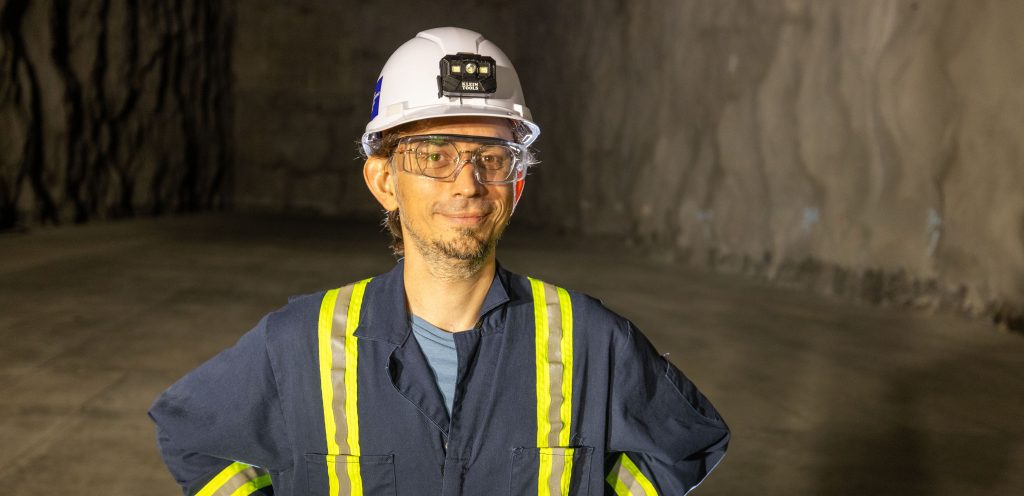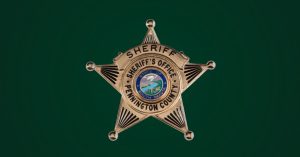Artist brings interactive sculptures to Deep Talks and Black Hills State University’s Ruddell Gallery
Lead, SD — Touching a famous painting or priceless artifact in a museum can get you in trouble.
But Chris Combs wants you to interact with his creations. Combs is the 2025 Artist in Residence (AiR) at the Sanford Underground Research Facility (SURF), and most of his artwork is designed for people to reach out and touch.
“A lot of my artwork has buttons that you can push or things you can tap, or things that change as you look at them. And to me, that’s like a little extra kind of superpower I get to employ. This is not like a museum exhibit,” Combs said.
This superpower allows visitors to experience the artwork with a wider range of senses. From his studio at Otis Street Arts Project in Washington, D.C., Combs shared details about his upcoming exhibition at the Ruddell Gallery on the campus of Black Hills State University. The show will feature interactive and time-based sculptures made with found objects, metal, wood and industrial materials. Many of the materials—many of which he sourced during his time at SURF this summer.
“And being able to use just sort of discarded materials in my art hopefully helps sort of invoke the deep local history of both the mine and the lab, and hopefully help people sort of place them in the mindset of what it’s really like to be working in this facility so deep underground,” he said.
One central installation, Little Ones, places visitors into the perspective of the neutrino by allowing them to “collide” with hanging “atoms.” The work features used copper gaskets from the LUX-ZEPLIN dark matter detector at SURF hanging from the ceiling in a darkend room. Custom-built circuit boards wired inside the copper gaskets light up and interact with those who choose to engage.
“I was wondering what it’s like to be a neutrino. You know, you’re this thing that can hurtle through a light-year or more of lead without ever encountering any of the atoms. I hope to capture what it’s like to be propelled through a space and maybe you interact with an atom, or maybe not,” Combs said.
In another installation, titled Starstuff, Combs employs objects such as an old ammo box found in a former mine car, a discarded mirror from a locker once used at the SURF Foundry and a video of a Black Hills waterfall.
“If you peer in this mirror and you look around, you see sparkling stars reflected over you, and those are just me filming the surface of Roughlock Falls,” Combs said. “Each of the bright speckles from the sun reflecting off the waterfall turns into star shapes in the video. This seething mass of stars bubbling away from your reflection. And to me, it speaks to this idea that with all this research and all this work, we’re really sort of trying to figure out how and why we exist.”
Combs’ work celebrates both the scientific endeavor at SURF and the labor it takes to operate the facility.
“This research all boils down to real-world things that are 4,850 feet underground. They take a lot of work to get there, and they take a lot of work to keep running. Seeing these sort of gritty, dirty, used materials hopefully will help people sort of intuitively grasp that it takes a lot of brute force and labor to make the science happen,” Combs said.
Exploring the wonder, mystery and hard work of advancing world-class science at SURF these interactive art works—that employ buttons, lights and sounds—have the potential to bring out the kid in all of us. At the same time, they inspire learning across generations, a key part of SURF’s mission.
“I think that sculptures with these materials have the fun power of being almost an enchanted device. It’s kind of like, a video game element in real life. I would encourage those with kids at home who are learning STEAM, or those who might be interested in electronics or computers or engineering or math people to come check this out,” Combs said.
For Gina Gibson, SURF’s AiR coordinator and a professor of digital communications at Black Hills State University, the works are not only fun for all ages but also approachable for everyone.
“Chris is a sponge, and it’s been fun watching him explore all things SURF, and I can hardly wait to see the artwork myself. He has a gift in explaining the work and in inspiring curiosity and excitement,” Gibson said.
Combs will be sharing behind-the-scenes views of the artwork and his artistic process beginning at 5 pm during the Oct. 2 installation of SURF’s monthly Deep Talks series. He will also be on-hand a public opening reception at 5–7 p.m. on Oct. 7, at BHSU’s Ruddell Gallery.
The AiR program at SURF is now in its sixth year. This residency is modeled after various programs offered by government, science, and industry, including the National Park Service, CERN, and Fermilab. For more information visit SURF AiR program website.





